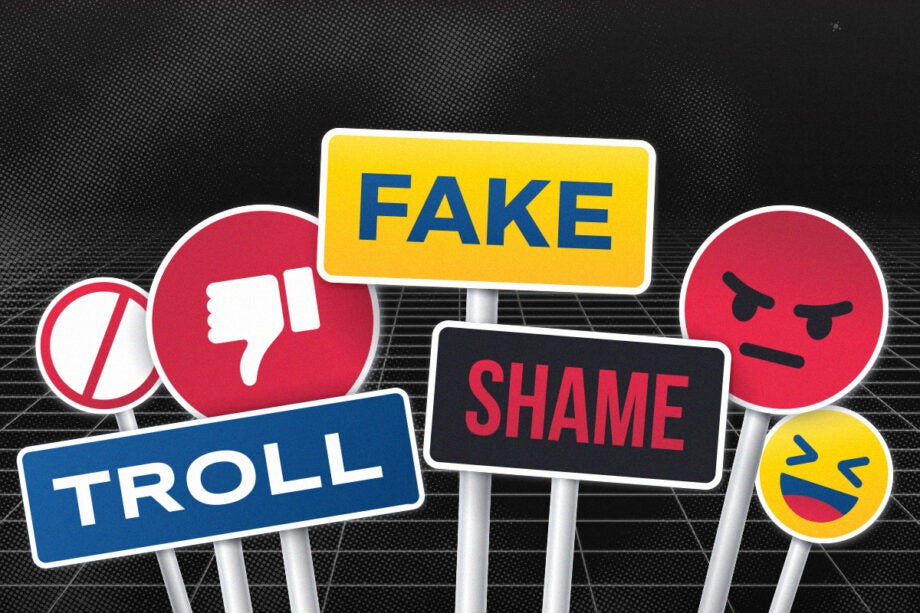What is cyberbullying?

Online harassment can happen to anyone, but cyberbullying is the term most commonly used when children receive online threats and abuse from their peers. As young people, like the rest of us, go online to study, socialise and play, bullying has also migrated to their online interactions.
One in three children is estimated to have experienced cyberbullying in some form, according to information from cybersecurity firm ESET, working in cooperation with psychologist Jarmila Tomková. Research shows that cyberbullying goes hand-in-hand with offline bullying and most frequently involves peers from children’s day-to-day lives. Digital tools and spaces are simply another avenue for attackers to harm their victim.
This form of peer abuse was in some cases exacerbated by the move to online schooling in the face of the Covid-19 pandemic. In 2020/21 the NSPCC’s Childline service delivered 2,500 counselling sessions on cyberbullying.
One 14-year-old who contacted the charity said: “The bullying I used to get at school has gone online now because we are not going to school due to the virus. I am getting horrible messages sent to me and nasty comments about everything I post. One message that really upset me said my mum was going to die of coronavirus. The bullying is getting worse now than when I was at school.”
Because online environments have their own distinct forms of interaction, mediated by the tools available (such as posts and blogs, social media likes and comments, video and image sharing), cyberbullying can look a little different to its offline equivalent, and it can be harder for the victim to get away from.
According to ESET, cyberbullying most frequently occurs on social network, in group chats, via direct messages sent to the victim’s mobile device and in email messages.

Kaspersky Home Security
Keep your online activity safe and private across multiple devices – without compromising speed.
Check out Kaspersky’s new security plans from just £10.99 per year
- Kaspersky
- money back guarantee
- from £10.99
Examples of cyberbullying
- Provocation of the victim with messages and posts containing offensive, false, unacceptable or vulgar content
- Threats and blackmail, potentially involving hijacked social media profiles
- Public humiliation and ridicule on social media or in group chats
- Defamation of the victim, for example by spreading rumours and lies with the intention of damaging their reputation and relationships
- Identity theft of the victim or something close to them with the intention of inflicting harm on them
- Publishing the victim’s private or intimate information without their consent
- Deliberately excluding the victim from their peer group’s online communities, done suddenly so as to be sure that they notice and feel isolated
- Harassment and cyberstalking – this can include an overwhelming wave of positive attention such as likes and comments, taken to intrusive levels, or it can be distinctly negative in tone, going so far as threats of physical harm, false accusations, damage to the victim’s data and offline stalking
Signs that your child may be being bullied online
- Not wanting to go to school or take part in normal activities
- Getting anxious or angry if you go near their device
- Feeling withdrawn, upset or angry at home
- Problems sleeping or eating
- Having angry outbursts that seem out of character
- Spending more or less time online than normal
- New harmful patterns in the child’s behaviour, such as substance abuse, truancy or self-harm
- Psychosomatic symptoms such as stomach aches or headaches
What to do about cyberbullying
The NSPCC offers the following advice to children experiencing cyberbullying in the UK:
- Share how you are feeling with other young people. Childline’s online message board is a non-judgemental space where you can speak to other children who are in a similar situation to you about your experiences and feelings. This can help you feel less alone and will give you an online support network that you can turn to.
- Talk to an adult you trust about the bullying you are experiencing so you feel less alone and so that adult can support you. This could be a parent, teacher or you can speak to a Childline counsellor on 0800 1111 or online at childline.org.uk
- Take a break from your device if you are being bullied online and do something you enjoy such as sport, listening to music or art.
- Remember the bullying is not your fault.
- Get into a healthy routine and make sure you look after yourself by eating healthily, getting enough sleep and taking time out for yourself.
- Report and block someone if they are sending you messages online that upset you.
And for parents and guardians who suspect that their child may be being cyberbullied:
- Talk to your child and remind them to come to you with anything that might be making them feel anxious or sad. If your child speaks to you about an experience of bullying that they’ve had online or in person, try to remain calm and don’t overwhelm them with questions. Reassure them that it will be ok, and that you’re always there for them.
- Show them how to report or block a message that they’ve received from someone online that upsets or worries them.
- Don’t take their device away if they’ve had a negative experience online. Although you may want to do this if they are upset, this may make them feel like whatever has happened is their fault. Instead, suggest they take some time away from the app they received the messages on and do another online activity they enjoy like playing a game.
- Know where you can get further support. Those looking for further support can visit the NSPCC’s Online Safety hub. Parents and carers can visit the hub to find advice and tips to help keep kids safe online. This includes pages for social media, online gaming and parental controls, explaining the risks and steps you can take to help keep your kids safe online. There’s also information on what parents need to know about topics such as sharing nudes, livestreaming, harmful content and online reporting.
Where cyberbullying is being carried out by a child’s offline peer group, ESET highlights the important role of teachers in monitoring and stopping harassment and helping children to resolve conflicts and maintain functioning relationships with their peers.

Kaspersky Home Security
Keep your online activity safe and private across multiple devices – without compromising speed.
Check out Kaspersky’s new security plans from just £10.99 per year
- Kaspersky
- money back guarantee
- from £10.99
If action needs to be taken against a cyberbully, it’s important to store the bullying communication as evidence, in the form of SMS messages, chat messages, humiliating photographs, comments or screenshots of online applications
Where possible, accounts belonging to bullies should be blocked and prevented from further interaction with the victim. However, in the case of offline relationships, further resolution is likely to be required, involving parents, teachers and other professionals involved in the child’s welfare.
This article draws on information provided by the NSPCC and ESET. All names and potentially identifying details have been changed to protect the identity of the child or young person. Quotes are created from real Childline service users but are not necessarily direct quotes from the child or young person.


